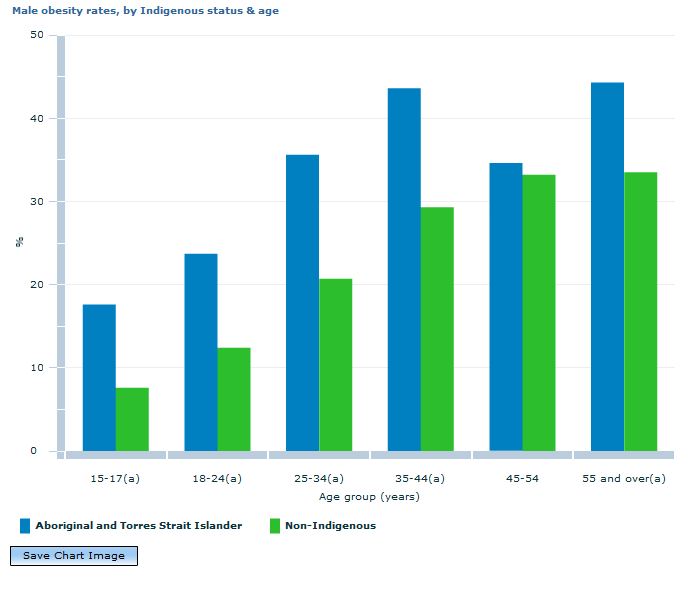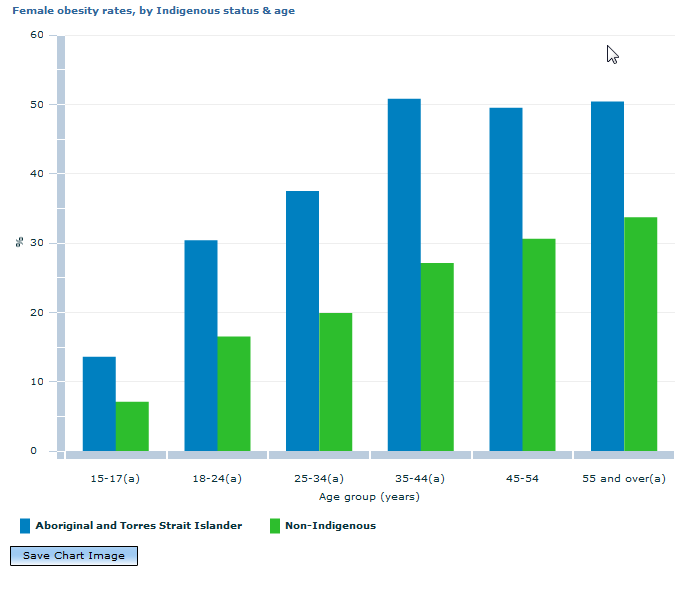4727.0.55.001 - Australian Aboriginal and Torres Strait Islander Health Survey: First Results, Australia, 2012-13
ARCHIVED ISSUE Released at 11:30 AM (CANBERRA TIME) 27/11/2013 First Issue
Page tools:
 Print Page Print Page
 Print All Print All
| ||||
|
Being overweight or obese increases a person's risk of developing cardiovascular disease, high blood pressure and/or Type 2 diabetes. These have significant implications for the health sector in terms of cost and burden on services, and may affect a person's quality of life through the inability to work or participate in family and community activities. The 2003 Australian Burden of Disease Study estimated that high body mass accounts for 11% of the total burden of disease and injury for Aboriginal and Torres Strait Islander people (Endnote 1). In the 2012–13 Australian Aboriginal and Torres Strait Islander Health Survey, measured height and weight were collected to determine a person's Body Mass Index (BMI), a common measure for defining whether a person is underweight, normal weight, overweight or obese. BMI data for 2012–13 are not comparable with previous ABS National Aboriginal and Torres Strait Islander Health Surveys or National Health Surveys, in which BMI were mainly based on self-reported height and weight. For information on how BMI is calculated see Body Mass Index in the Glossary. BMI was only calculated for people for whom both height and weight were measured. In 2012–13, 80.6% of Aboriginal and Torres Strait Islander people aged two years and over had their height and weight recorded. Height and weight measurements were obtained from 76.7% of Aboriginal and Torres Strait Islander children aged 2–14 years, and 82.5% of Aboriginal and Torres Strait Islander people aged 15 years and over. The results below are based on this measured population only. Adults were classified as being overweight if their BMI was greater than 25.00 but less than 29.99, and as obese if their BMI was 30.00 or more. While the formula to calculate BMI scores was the same for adults and children, the classification of children's BMI was different to that of people aged 18 years and over, and took into account individual age and sex. RESULTS FROM 2012–13 Children aged 2–14 years In 2012–13, almost one-third (30%) Aboriginal and Torres Strait Islander children aged 2–14 years were overweight or obese (20% and 10% respectively), according to their BMI. Three in five Aboriginal and Torres Strait Islander children (62%) were in the normal weight range and 8% were underweight. COMBINED OVERWEIGHT/OBESITY RATES BY AGE, Aboriginal and Torres Strait Islander children —2012–13 Combined overweight/obesity rates were similar for Aboriginal and Torres Strait Islander boys and girls (29% and 32%, respectively).People aged 15 years and over In 2012–13, two-thirds (66%) Aboriginal and Torres Strait Islander people aged 15 years and over were overweight or obese (29% and 37% respectively), according to their BMI. Combined overweight/obesity rates were higher for Aboriginal and Torres Strait Islander females than males (67% compared with 64%), mainly due to higher obesity rates for females. COMBINED OVERWEIGHT/OBESITY RATES BY SEX AND AGE, Aboriginal and Torres Strait Islander people —2012–13 Aboriginal and Torres Strait Islander females generally have higher obesity rates than males, however the only statistically significant difference in rates was in the 45–54 year age group (50% compared with 35%). OBESITY RATES BY SEX AND AGE, Aboriginal and Torres Strait Islander people —2012–13 Combined overweight/obesity rates were significantly higher in non-remote areas than in remote areas (67% compared with 61%). Physical inactivity is associated with high body mass which accounts for 11% of the total burden of disease and injury in the Aboriginal and Torres Strait Islander population (Endnote 1). Poor nutrition can also contribute to high body mass. Results from Exercise levels (Exercise levels) for non-remote areas in 2012–13 show three in five (62%) Aboriginal and Torres Strait Islander people aged 18 years and over reported that they were physically inactive (that is, sedentary or had exercised at a low level) in the previous week. In 2012–13, less than half (43%) of Aboriginal and Torres Strait Islander people aged 15 years and over reported eating an adequate amount of fruit (Daily fruit and vegetable intake) each day, and only one in twenty (5%) reported eating an adequate amount of vegetables each day (Daily fruit and vegetable intake) . HOW DO THESE RATES COMPARE WITH THE RATES FOR NON-INDIGENOUS PEOPLE? After adjusting for differences in age structure between the two populations, the combined overweight/obesity rates for Aboriginal and Torres Strait Islander people aged 15 years and over were similar to those for non-Indigenous people (rate ratio of 1.1). However, obesity rates for Aboriginal and Torres Strait Islander females and males were higher than the comparable rates for non-Indigenous people in every age group. Overall, after adjusting for differences in age structure between the two populations, Aboriginal and Torres Strait Islander people were 1.5 times as likely as non-Indigenous people to be obese (rate ratio of 1.4 for males and 1.7 for females).
 Footnote(s): (a) Difference between Aboriginal and Torres Strait Islander and non-Indigenous rate is not tatistically significant. Source(s): 2012-13 Australian Aboriginal and Torres Strait Islander Health Survey and 2011-12 Australian Health Survey  Footnote(s): (a) Difference between Aboriginal and Torres Strait Islander and non-Indigenous rate is not statistically significant. Source(s): 2012-13 Australian Aboriginal and Torres Strait Islander Health Survey and 2011-12 Australian Health Survey ENDNOTE 1. Vos T, Barker B, Stanley L, Lopez AD 2007. The Burden of Disease and Injury in Aboriginal and Torres Strait Islander peoples 2003, School of Population Health, The University of Queensland, Brisbane.
|
|||
